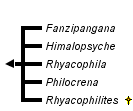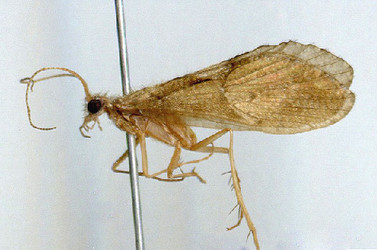Rhyacophilidae
Karl Kjer


This tree diagram shows the relationships between several groups of organisms.
The root of the current tree connects the organisms featured in this tree to their containing group and the rest of the Tree of Life. The basal branching point in the tree represents the ancestor of the other groups in the tree. This ancestor diversified over time into several descendent subgroups, which are represented as internal nodes and terminal taxa to the right.

You can click on the root to travel down the Tree of Life all the way to the root of all Life, and you can click on the names of descendent subgroups to travel up the Tree of Life all the way to individual species.
For more information on ToL tree formatting, please see Interpreting the Tree or Classification. To learn more about phylogenetic trees, please visit our Phylogenetic Biology pages.
close boxIntroduction
Rhyacophilidae is a relatively large family, originally established by Stephens (1836). At one time the family included also Glossosomatidae and Hydrobiosidae and other taxa, but its definition has progressively become more restricted. Evolutionary relationships of the family were discussed by Ross (1956) and the family was the subject of a large revision by Schmid (1970). The family is predominantly north temperate and is found in North America, Europe, and Asia, but also extends into India and the tropical areas of southeastern Asia. Currently most of the diversity is included in a single genus, Rhyacophila Pictet, the largest genus in Trichoptera, with over 700 species and additional ones regularly being described. In addition to the landmark works of Ross and Schmid on Rhyacophila, Prather and Morse (2001) studied the phylogeny of the R. invaria group from eastern North America and Mey (1999) investigated the biogeography of Southeast Asian members of the genus. Other genera include Himalopsyche Banks (ca. 50 species, predominantly in the eastern Palaearctic and Oriental regions, but with 1 species from western North America), Philocrena Lepneva (1 species from Georgia, western Palaearctic), and Fansipangana Mey (a single species recently described from Vietnam).
Characteristics
The family is 1 of 2 (the other being Hydrobiosidae) that includes species that are free-living and predaceous as larvae, constructing a domed pupal chamber of rocks at maturity. As the etymology of the family name indicates, the larvae frequent cool, fast flowing rivers and streams. Larvae in the genus Himalopsyche, and some in the genus Rhyacophila, possess abdominal and thoracic gills, quite different from those in Integripalpia or Hydropsychidae. (From Holzenthal et al. 2007a)
Discussion of Phylogenetic Relationships
Ivanov (2002, see also Ivanov & Sukatcheva 2002) proposed that Rhyacophilidae and Hydrobiosidae are sister taxa allied to the Annulipalpia. Combined molecular and morphological data place Rhyacophilidae in a clade that includes the other "spicipalpian" families (Hydrobiosidae, Glossosomatidae, and Hydroptilidae) and Integripalpia (Kjer et al., 2001; 2002; Holzenthal et al., 2007b), although its position within this clade is unstable.
References
Holzenthal R.W., Blahnik, R.J., Prather, A.L., and Kjer K.M. 2007a. Order Trichoptera Kirby 1813 (Insecta), Caddisflies. In: Zhang, Z.-Q., and Shear, W.A. (Eds). 2007 Linneaus Tercentenary: Progress in Invertebrate Taxonomy. Zootaxa. 58 pp. 1668:639-698
Holzenthal R.W., Blahnik, R.J., Kjer K.M and Prather, A.L. 2007b. An update on the phylogeny of Caddisflies (Trichoptera). Proceedings of the XIIth International Symposium on Trichoptera. Bueno-Soria, R. Barba-Alvearz and B. Armitage (Eds). pp. 143-153. The Caddis Press.
Ivanov, V.D. & Melnitsky, S.I. (2002) Structure of pheromone glands in Trichoptera. Nova Supplementa Entomologica (Proceedings of the 10th International Symposium on Trichoptera), 15, 1728.
Ivanov, V.D. & Sukatcheva, I.D. (2002) Order Trichoptera Kirby, 1813. The caddisflies (=Phryganeida Latreille, 1810). In: Rasnitsyn, A.P. & Quicke, D.L.J. (Eds.) History of Insects. Kluwer Academic Publishers, Dordrecht, The Netherlands, pp. 199222.
Kjer, K.M., Blahnik, R.J. & Holzenthal, R.W. (2001) Phylogeny of Trichoptera (caddisflies): characterization of signal and noise within multiple datasets. Systematic Biology, 50, 781816.
Kjer, K.M., Blahnik, R.J. & Holzenthal, R.W. (2002) Phylogeny of caddisflies (Insecta, Trichoptera). Zoologica Scripta, 31, 8391.
Mey, W. (1999) Origin and formation of the distributional patterns of Rhyacophila species in the islands of South-East Asia. Senckenbergiana Biologica, 78, 193203.
Prather, A.L. & Morse, J.C. (2001) Eastern Nearctic Rhyacophila species, with a revision of the Rhyacophila invaria group (Trichoptera: Rhyacophilidae). Transactions of the American Entomological Society, 127, 85166.
Ross, H.H. (1956) Evolution and Classification of the Mountain Caddisflies. University of Illinois Press, Urbana, 213 pp.
Schmid, F. (1970) Le genre Rhyacophila et la famille des Rhyacophilidae (Trichoptera). Memoires de la Société Entomologique du Canada, 66, 1230.
Stephens, J.F. (1836) Illustrations of British Entomology; or a Synopsis of Indigenous Insects: Containing their Generic and Specific Distinctions; with an Account of their Metamorphoses, Times of Appearance, Localities, Food, and Economy, as far as Practicable. Mandibulata. Vol. VI. [Trichoptera, pages 146208]. Baldwin and Cradock, London, 240 pp.
Title Illustrations

| Scientific Name | Rhyacophila relicta |
|---|---|
| Location | Galicia Spain |
| Specimen Condition | Dead Specimen |
| Identified By | Ralph W. Holzenthal |
| Sex | Male |
| Collection | Univeristy of Minnesota UMSP |
| Source Collection | Barcode of Life Database (BOLD) |
| Image Use |
 This media file is licensed under the Creative Commons Attribution-NonCommercial-ShareAlike License - Version 3.0. This media file is licensed under the Creative Commons Attribution-NonCommercial-ShareAlike License - Version 3.0.
|
| Copyright |
© Karl Kjer

|
About This Page
Karl Kjer

Rutgers University, New Brunswick, New Jersey, USA
Correspondence regarding this page should be directed to Karl Kjer at
Page copyright © 2010 Karl Kjer
 Page: Tree of Life
Rhyacophilidae.
Authored by
Karl Kjer.
The TEXT of this page is licensed under the
Creative Commons Attribution-NonCommercial License - Version 3.0. Note that images and other media
featured on this page are each governed by their own license, and they may or may not be available
for reuse. Click on an image or a media link to access the media data window, which provides the
relevant licensing information. For the general terms and conditions of ToL material reuse and
redistribution, please see the Tree of Life Copyright
Policies.
Page: Tree of Life
Rhyacophilidae.
Authored by
Karl Kjer.
The TEXT of this page is licensed under the
Creative Commons Attribution-NonCommercial License - Version 3.0. Note that images and other media
featured on this page are each governed by their own license, and they may or may not be available
for reuse. Click on an image or a media link to access the media data window, which provides the
relevant licensing information. For the general terms and conditions of ToL material reuse and
redistribution, please see the Tree of Life Copyright
Policies.
- First online 17 July 2010
- Content changed 20 July 2010
Citing this page:
Kjer, Karl. 2010. Rhyacophilidae. Version 20 July 2010 (under construction). http://tolweb.org/Rhyacophilidae/14586/2010.07.20 in The Tree of Life Web Project, http://tolweb.org/







 Go to quick links
Go to quick search
Go to navigation for this section of the ToL site
Go to detailed links for the ToL site
Go to quick links
Go to quick search
Go to navigation for this section of the ToL site
Go to detailed links for the ToL site